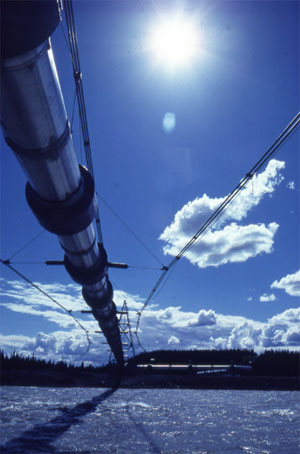BP turns off the oil, bacteria to blame
We first looked into energy giant British Petroleum 5 months ago as they struggled to minimize the effect of a small (250,000 barrel) spill at their head pipeline distribution center,Pipeline spill update. That spill went unnoticed for several days before being accidentally discovered during a routine maintenance inspection. The spill was quickly contained without interruption of service, which daily pumps nearly 200 thousand gallons of highly corrosive crude oil through its "feeder" lines to Alyeska, the Federally controlled and inspected main pipeline south. View our interactive satellite image of the Alyeska Pipeline where it spans the Yukon River.
 The reason, the spill occurred when a small pinhole appeared in a 34-inch diameter pipe connecting one of BP's lesser pump fields, before the main pipeline starts south. The hole, the diameter of a pencil sprayed oil into a ditch, which slowly grew to form a small lake covering about 2 acres. The spill remained hidden covered by fresh snowfall.
The reason, the spill occurred when a small pinhole appeared in a 34-inch diameter pipe connecting one of BP's lesser pump fields, before the main pipeline starts south. The hole, the diameter of a pencil sprayed oil into a ditch, which slowly grew to form a small lake covering about 2 acres. The spill remained hidden covered by fresh snowfall.
Now it seems that BP once again has a problem with their aging pipeline this however potentially could become much more serious. Engineers inspecting the system discovered a large segment of the main trunk pipe had become dangerously corroded and threatened to burst. The pipes were intended to have a life span of 10 years, a period exceeded in some sections now by almost 4 years. To make matters worse the line now carries not the higher-grade oil originally pumped from Alaska's North Slope but rather a lower grade crude. The low-grade oil contains significant amounts of sediment and salt water, which accelerates corrosion in the pipeline - think of your car in winter.
A maintenance procedure called “pigging”, or firing a solid object called a “pig” down the pipe to clean its interior walls is a normal method employed by pipeline companies to remove the sludge, which builds up along the line and can lead to corrosion. Maintenance records indicate BP officials have restricted the use of “pigging” over the past few years in an effort to increase production and minimize down time. BP has now closed the pipeline for an indeterminate period, a shutdown that promises to send oil prices soaring, and may have a direct impact on California. Alaska supplies nearly 20 percent of the oil produced by California's refineries.
According to Bob Malone, Chairmain and President of BP America in an interview today on CNN, the problem arose when workers discovered a bacterial growth in the sludge collecting in those pipes. The bacteria he said, "secretes an acid", which is believed to have accelerated the corrosion. He would not speculate on a time frame for the planned repairs.
The good news is that, this time at least, an injury to the environment seems to have been avoided but the cost may still threaten future disaster if BP is not willing to ratchet back its egregious desire for triple digit profits at the expence of an effective, proactive maintenance program.
By Harlan Weikle
Greener Magazine
 The reason, the spill occurred when a small pinhole appeared in a 34-inch diameter pipe connecting one of BP's lesser pump fields, before the main pipeline starts south. The hole, the diameter of a pencil sprayed oil into a ditch, which slowly grew to form a small lake covering about 2 acres. The spill remained hidden covered by fresh snowfall.
The reason, the spill occurred when a small pinhole appeared in a 34-inch diameter pipe connecting one of BP's lesser pump fields, before the main pipeline starts south. The hole, the diameter of a pencil sprayed oil into a ditch, which slowly grew to form a small lake covering about 2 acres. The spill remained hidden covered by fresh snowfall.Now it seems that BP once again has a problem with their aging pipeline this however potentially could become much more serious. Engineers inspecting the system discovered a large segment of the main trunk pipe had become dangerously corroded and threatened to burst. The pipes were intended to have a life span of 10 years, a period exceeded in some sections now by almost 4 years. To make matters worse the line now carries not the higher-grade oil originally pumped from Alaska's North Slope but rather a lower grade crude. The low-grade oil contains significant amounts of sediment and salt water, which accelerates corrosion in the pipeline - think of your car in winter.
A maintenance procedure called “pigging”, or firing a solid object called a “pig” down the pipe to clean its interior walls is a normal method employed by pipeline companies to remove the sludge, which builds up along the line and can lead to corrosion. Maintenance records indicate BP officials have restricted the use of “pigging” over the past few years in an effort to increase production and minimize down time. BP has now closed the pipeline for an indeterminate period, a shutdown that promises to send oil prices soaring, and may have a direct impact on California. Alaska supplies nearly 20 percent of the oil produced by California's refineries.
According to Bob Malone, Chairmain and President of BP America in an interview today on CNN, the problem arose when workers discovered a bacterial growth in the sludge collecting in those pipes. The bacteria he said, "secretes an acid", which is believed to have accelerated the corrosion. He would not speculate on a time frame for the planned repairs.
The good news is that, this time at least, an injury to the environment seems to have been avoided but the cost may still threaten future disaster if BP is not willing to ratchet back its egregious desire for triple digit profits at the expence of an effective, proactive maintenance program.
By Harlan Weikle
Greener Magazine



1:44 PM









<< Home